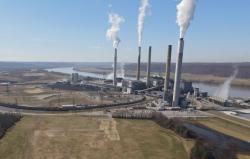
OR WAIT null SECS
© 2024 MJH Life Sciences™ and Turbomachinery Magazine. All rights reserved.
Recips vs. combustion turbines in mid-sized power
Recent advances in reciprocating engine technology and system design have ensured that in some sites, the reciprocating engine is being chosen over the combustion turbine for mid-sized power plants, say 50 MW. Every site is unique, and specific site attributes can have a major impact on the financial viability of a project in general, and on the selection of the appropriate technology.
Below are excerpts from the paper, "Mid-sized new generation: Reciprocating internal combustion engines or combustion turbine?" presented at Power Gen International 2017 by Melanie J. Schmeida of Louis Perry Group.
Footprint
CT systems utilize approximately one-third to one-quarter of the area needed for equivalent RICE (reciprocating internal combustion engine) generation. Additionally, CTs are relatively lighter weight and do not require substantial support foundations, resulting in less site work overall. This difference in footprint is accounted for in the installation cost of the project, including the typical EPC costs referenced in this paper. However, beyond the common installation costs, this difference in footprint can result in additional costs to the project. For a brownfield site, this may mean additional demolition or remediation services are required. Or for a landlocked area, the expense to purchase additional land could make selection of RICE prohibitively expensive.
Ambient Conditions
Reciprocating engine performance is impacted very little by changes to the incoming air conditions, therefore air pressure reductions at high altitude (up to 3,000-ft above sea level or more) and large ambient temperature ranges (up to 100 °F) do not significantly affect operations. Conversely, CT performance may degrade as much as 10-15% from ISO conditions for the same range due to incoming air properties. High altitude installations need to adjust heat rate/efficiencies in their performance model to properly represent the expected output. To combat the degraded performance for CT at high air temperatures, an inlet air cooler is often Page 7 of 13 installed. This results in improved efficiency of the CT, but requires additional capital expenditure, and operating expense in the form of water usage. Either technology can be effectively utilized, but RICE has the advantage of maintaining base performance.
Natural Gas Pressure
Combustion turbines require much higher inlet gas pressure than RICE, 300-600 psig vs 75-150 psig. If the site has access to a high pressure natural gas line, this may not be of much concern. However, most owners do not have such luxury, and therefore will need to install gas compressors for a CT installation. These compressors are noteworthy pieces of equipment in their own right, with significant capital and O&M expenditures required.
Noise
Both technologies will generate far-field noise when in operation, so proximity to receptors will be a concern regardless of selection. Typically, specifically engineered sound enclosures and/or buildings will be sufficient; however, RICE tend to generate higher frequency noise that is more difficult to control than the lower frequencies produced by CTs. If the site is in an area with sensitive receptors, additional sound mitigation measures may be required, resulting in increased capital costs for the RICE.
Emissions
Both technologies are efficient combustors and have low resulting emissions, and both can be outfitted with selective catalytic reduction (SCR) systems for NOx and CO control. This is an area where the fast start and response time of RICE can be a detriment, as the emissions control equipment does not respond as quickly. During start-up or fast ramping, emissions levels may fluctuate, causing temporary spikes. Average emissions limits are not likely to be a concern in most parts of the U.S., however, permits need to be reviewed carefully for instantaneous or peak allowable emissions levels. Restrictions on instantaneous levels may restrict operational flexibility, resulting in loss of function that impacts the project pro forma.
Water Availability
As noted above, for high ambient temperature installations, CTs will often be outfitted with an inlet air cooler, which will require high purity water. Some CT models also require water injection for cooling and emissions controls. If water scarcity, or the cost of demineralized water, is a concern at a site, the resulting operating costs may favor RICE. Reciprocating engines require an external cooling circuit, but typically utilize a closed-loop system with minimal make-up water needs.
Future Expansion
Both CT and RICE equipment can be supplied as modular units, which can reduce installation costs by shifting labor from the field to the shop. Additional units can be added on site as a path to expand generation capacity in the future. Due to the smaller size of the RICE units, it is far more practical to incrementally expand capacity by adding one engine at a time than it is for CT. If incremental expansion is a possibility for a facility, RICE will permit that expansion, whereas additional CTs will result in major step changes.



